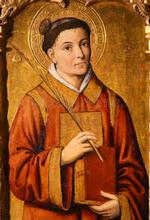Kevalaer
by Zsolt Aradi
The most important North German shrine to Mary, Kevelaer, was founded by a peddler and two simple foot soldiers, who marched homeward to the Rhineland in 1642.
The image of Our Lady and her Child in the Kevelaer sanctuary is neither an original nor even a carefully executed work of art. It is a copy of a picture of Our Lady of Luxembourg, a small engraving sold in that city as any other holy picture is sold today in churches, or in stores carrying religious articles. For the two soldiers who had been stationed in Luxembourg for a long time, there was nothing more natural than to take home such a holy picture as a souvenir.
These soldiers were typical of hundreds of thousands of Germans, French, Dutch, and other European common folk who served in the armies of their respective warlords.
But as happened so frequently in those days, the disbanded soldiers had been left without means. When these two discharged landsers reached the village of Kleve they were near starvation and their most valuable property, aside from their clothing, were those two holy pictures. In desperation, they tried to sell them in order to obtain food. They knocked on the door of a house, which belonged to a peddler named Busmann. He was out on one of his frequent wearying journeys around the hills; his wife had no money.
Busmann, the peddler, was on the march homeward too. He did not know that the soldiers had come to his door. Nearing his hometown, on the top of a hill called Kevelaer, he stopped at the wayside Crucifix to say a prayer. At this moment, he heard an inner voice. This voice told him that he should build a "little holy house." Though he was not an excessively pious man, he had no doubt in his heart that it was Mary who commanded this.
The third important role concerned with the foundation of Kevelaer--after the soldiers and the peddler--belongs to the peddler's wife. When Busmann arrived home the following morning, he found his wife in a state of great excitement. She told him that in her dream she had seen the pictures offered for sale by the soldiers surrounded by the most brilliant rays of light.
Busmann was now determined to erect a "little holy house" on that spot where he had heard the inner voice. It was not an easy task to trace the two soldiers; and when he finally found them, it was only to discover that the soldiers had given the pictures to a wounded officer who was more in need of help than they were.
Hendrik Busmann was not one to be stopped by obstacles. He felt certain that he would be able to fulfill his mission. And so, he searched out the wounded officer who gave him one of the pictures representing Our Lady of Luxembourg, and shortly thereafter he erected, with his own hands, a small brick pillar, put a roof on top of it, and placed the picture in the niche.
The little shrine immediately attracted people from all over the Rhineland. Within a year thousands had arrived and one miraculous event after another had taken place. At the twenty-fifth anniversary of the erection of the shrine, there were nearly 30,000 persons attending on one day.
The thousands of pilgrims first built a chapel called Candle Chapel where people left their annual votive candles. The shrine itself remained untouched. Several hundred years later, however, the pillar bearing the small image, fastened with glue on a cardboard, was enshrined in a larger chapel, called the Chapel of Grace.
During the last three hundred years, Kevelaer from its humble beginnings has become as great as Altotting, which grew in the shadow of powerful rulers and great personalities.
This item 3055 digitally provided courtesy of CatholicCulture.org






